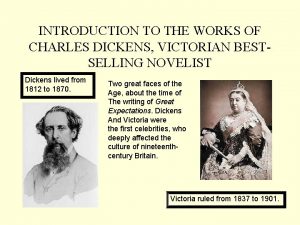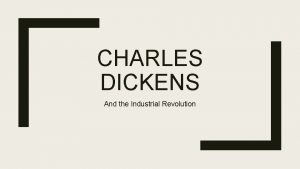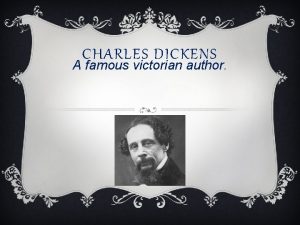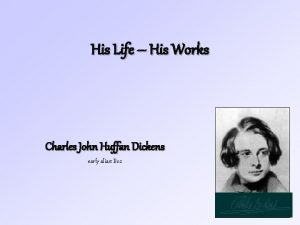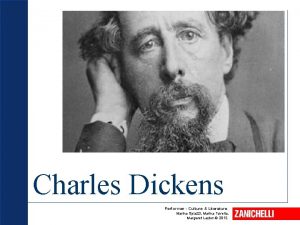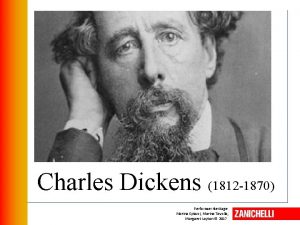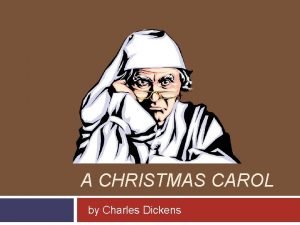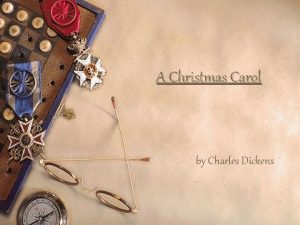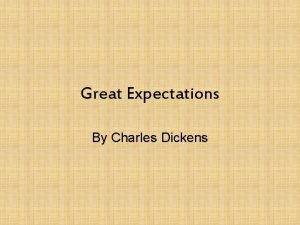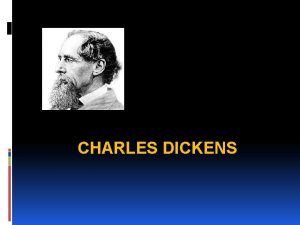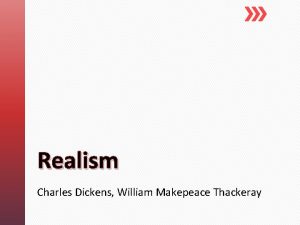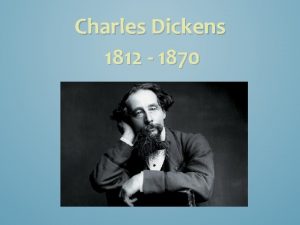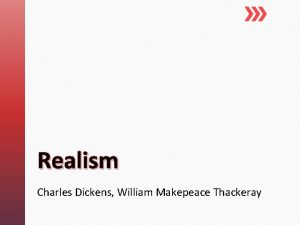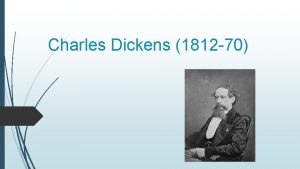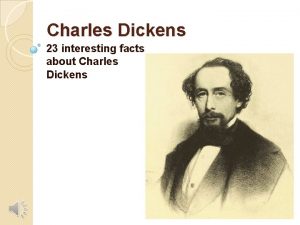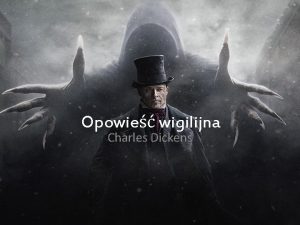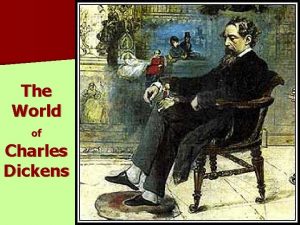INTRODUCTION TO THE WORKS OF CHARLES DICKENS VICTORIAN













- Slides: 13

INTRODUCTION TO THE WORKS OF CHARLES DICKENS, VICTORIAN BESTSELLING NOVELIST Dickens lived from 1812 to 1870. Two great faces of the Age, about the time of The writing of Great Expectations. Dickens And Victoria were the first celebrities, who deeply affected the culture of nineteenthcentury Britain. Victoria ruled from 1837 to 1901.

During Victoria’s reign, Britain’s empire became the largest, wealthiest, and most powerful in the world. Rule Britannia! Britannia rules the waves! Assisted by her navy, Britain extended her empire across the globe. Britain’s dominance would not be shaken until the Great War of 1914 -1918. London became a center of finance, and British industry profited from raw materials imported from colonies. John Dickens, father of Charles, was a clerk for the Royal Navy. Dickens grew up close to the sea, as does Pip in the novel.

Dickens’ birthplace in Portsmouth (second door from left) is now a museum During Dickens’ lifetime, railroads, steamships, and subways transformed transportation. The telegraph made communication almost instant. Dickens, in his novel Dombey and Son (1848) describes the building of the early railway system. Dickens made two visits to the United States, in 1842 and 1867 -68. Starting in 1837, he also traveled and lived for periods of time in Italy, Switzerland, and France. Concerned with the pirating of his work, he pressed for international copyright protection. • • • Advances in printing made books less costly. A mass reading market developed. Literacy gradually increased. The first universal education bill passed in 1870. Dickens was an advocate for education and other programs to alleviate poverty. An avid walker, Dickens often hiked several miles a day through country and city. Many scenes in his novels are urban, often based on actual locations in London, where the family moved in 1822. However, Dickens retained the concept of a rural or pastoral place of refuge, away from the stress of the city.

Building the first branch of the London Underground in 1861 (opening in 1863), now the Metropolitan Line Cheap, rapid transportation added to the wealth of the city, as access to jobs became easy. After “the big stink” of 1858, London in the 1860 s finally built an improved sewer and water system that greatly improved public health. London’s air pollution grew worse until “the Great Smog” of 1952 brought some regulation in 1956.

With great energy and determination, Dickens overcame difficulties and gained early success. • • His father’s debts eventually resulted in imprisonment in 1824 for three months. Humiliated, young Dickens worked at Warren’s Blacking factory for five months. Dickens never forgot the conditions of child labor in 1824 and the exploitation of the working class. A small inheritance freed John Dickens and allowed Charles to attend school at Wellington House Academy, 1825 -1827. Dickens’ own experience of child labor gave him an understanding of poverty and the working poor. • • • Dickens fell in love with Maria Beadnell in 1830, but her family opposed the match. Dickens taught himself shorthand became a Parliamentary reporter in 1831. His first story was published in 1833. His work was instantly successful. From 1834 -1836 he worked as a reporter for The Morning Chronicle and continued publishing short stories or “sketches. ” Dickens married Catherine Hogarth in 1836, with whom he would eventually have ten children.

Dickens’ London home from 1837 to 1839, a museum since 1925 Dr. Batten prepares to tour the museum in December, 2005. Special events were held in 2012 around the world to celebrate the bicentennial of Dickens’ birth

With his first novel, The Pickwick Papers in 18361837, Dickens became a best-selling novelist. • Dickens and his first publisher invented serial publication. Novels were issued in monthly issues or installments, each consisting of 32 pages and costing a shilling. • This method made novels affordable to a wide audience. A “full run” of issues could be bound together to make an complete novel. • Two novels, Great Expectations and A Tale of Two Cities, were also published in weekly issues of Dickens’ newspaper, All the Year ‘Round, over the course of eight months. • Illustrations were important to Dickens, though many modern editions omit them. Dickens worked closely with his illustrators to achieve accuracy and artistic unity. • Responsive to his readers, he sometimes altered his work to reflect the comments and criticisms that he received during the course of a novel’s serialization. • The MBA library has a facsimile set of Great Expectations issues. • Dickens novels were quickly translated into many languages.

Dickens’ oeuvre can be divided into three periods. • • • Early period: novels are episodic or loosely plotted, with many characters and comical scenes: Pickwick Papers (1837), Oliver Twist (1839), Nicholas Nickleby (1839), The Old Curiosity Shop (1841), Barnaby Rudge (1841), Martin Chuzzlewit (1844). Middle period: more tightly plotted novels, sharp social criticism: Dombey and Son (1848), David Copperfield (1850), Bleak House (1853), Hard Times (1854), Little Dorrit (1857). Late period: mature and complex themes and style: A Tale of Two Cities (1859), Great Expectations (1861), Our Mutual Friend (1865). Dickens also gave lucrative public readings starting in 1858. These were exhausting and may have affected his health, especially on his American tour of 1867 -68 and his “farewell” London readings in 1870, the year of his death. Beginning with his first novel, Dickens’ fiction had “legs”—capable of generating many products based on characters and scenes. Some of his characters, like Mr. Micawber and Pickwick, are larger than life, recognized even by people who have never read the novels in which they appear. Even before they completed their run, Dickens’ novels were turned into plays, with many unauthorized spin-offs. Movies and BBC dramatizations continue to the present day.

One of themes of Great Expectations is class mobility and aspirations. Dickens, whose paternal grandparents were upper-level servants, epitomizes the self-made man, rising from the lower-middle to the upper-middle class. Out walking one day, the boy Dickens and his father passed a large house. His father told him that, with hard work, he might buy that house one day. Dickens bought the house, Gad’s Hill Place, in 1856 and lived there until his death. A school for many years, it will soon be a museum.

Dickens’ created a scandal when he separated from his wife in 1858. • In 1857, he met and evidently fell in love with a beautiful young actress, Ellen Ternan, less than half his age. • Dickens helped to support Ellen and her mother in a separate establishment, and he continued to support his wife financially. • No one knows for sure whether Ellen and he were actually lovers. • Critics speculate that Sydney Carton, the hopeless alcoholic who loves Lucie Manette in A Tale of Two Cities, was inspired by Dickens’ affair with Ellen. • Another possibility is that Ellen was the model for Estella in Great Expectations, as John Dickens had been the model for Mr. Micawber in David Copperfield.

Dickens played a special role in popularizing Christmas customs. Upon hearing the news of Dickens’ death, a boy was reported to have asked, “Now that Mr. Dickens is dead, will Father Christmas go away as well? ” Dickens’ short novel, A Christmas Carol (1843), depicts such customs as the family celebration over a special meal of goose or turkey and the day’s holiday for poor workers such as Bob Cratchit. While elaborate Christmas celebrations were observed in villages and manors, they had not been sustained in the city until Dickens’ novel revived and altered them for an urban audience.

Fashions in Dickens’ time reflected the class structure and the importance of material wealth. A lady of 1820, about the time that Great Expectations opens. Below: A fashion print of 1861, when this novel was first published. Above: A family of status, a about 1812. Note that men’s clothing has changed less than women’s.

Some further fun facts for reading Great Expectations • Dickens’ style of writing is often playful, full of puns and double meanings. • Objects can have a life of their own: Joe’s file, for example. • In the class system of 1820, a wealthy brewer, such as Miss Havisham, was below the gentry, and far below the aristocracy. • A skilled laborer, such as a blacksmith, had much higher status than a farm-hand. The Gargery family is lower-middleclass. Most of Dickens’ novels are twice as long as this one and A Tale of Two Cities. • Many critics believe this to be Dickens’ best novel. • The novel is a bildungsroman, tracing the protagonist’s maturation. • It depicts and critiques the social/class/economic structure of Dickens’ time. • The first-person point of view is complex, or bifocal: Mr. Pirrip narrates, looking back on his life, as in autobiography. • Pip and Pirrip are palindromes. • Look for other trick names, such as “have-a-sham. ”
 Charles dickens time period
Charles dickens time period Chapter 11 great expectations
Chapter 11 great expectations Charles dickens prezentace
Charles dickens prezentace Charles dickens presentation
Charles dickens presentation Charles dickens view on the industrial revolution
Charles dickens view on the industrial revolution Charles dickens childhood facts
Charles dickens childhood facts Oliver tvist lektira
Oliver tvist lektira Huffan
Huffan Charles john huffan dickens
Charles john huffan dickens Performer culture and literature 3
Performer culture and literature 3 Performer heritage ppt
Performer heritage ppt Charles dickens biographical information
Charles dickens biographical information Biographical sketch outline
Biographical sketch outline Charles dickens contemporaries
Charles dickens contemporaries
